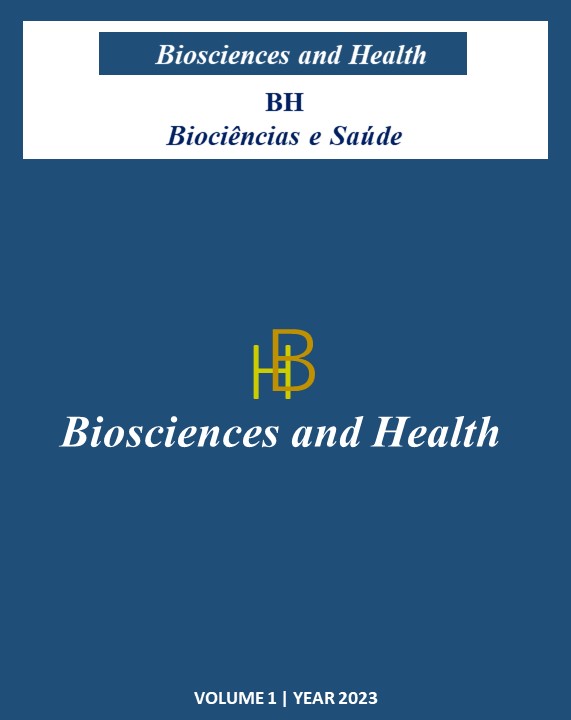Qualitative approach to the main symptoms and etiological factors of chronic obstructive pulmonary disease (COPD): integrative study
DOI:
https://doi.org/10.62331/2965-758X.v1.2023.36Keywords:
Risk Factors, Causality, Signs and symptoms, respiratory, Chronic obstructive pulmonary diseaseAbstract
Chronic obstructive pulmonary disease (COPD) is considered a public health problem that also involves global health. This disease is more common in the elderly, as they are subject to biopsychosocial changes and this increases the likelihood of acquiring infections, functional dependence and fragility of the organ system. In addition, other factors that can contribute to the development of COPD are Alpha1-antitrypsin deficiency, occupational exposure to dust, smoke and pollution. Furthermore, the disease can take years to develop, and its manifestation is more rapid in smokers, but with a high risk of death in smokers. The aim of the study was to search the databases for the main symptoms and etiological factors of COPD. The study is an integrative review with a qualitative approach to the proposed theme "main outcomes related to the etiological factors and symptoms of chronic obstructive pulmonary disease". The Virtual Health Library and PubMed/MedLine databases were used. The criteria adopted were articles from 2021 to 2023 in English and Portuguese. 235 articles were found, of which 4 were selected according to the study criteria. According to the literature, the etiological finding of COPD is smoking, which is the predominant risk factor for the disease.
References
Beghé B, Verduri A, Roca M, Fabbri LM. Exacerbation of respiratory symptoms in COPD patients may not be exacerbations of COPD. Eur Respir J. 2013; 41(4):993-995. https://doi.org/10.1183/09031936.00180812
Reis AP, Stirbulov R. Síndrome de sobreposição asma e DPOC. Arq Asma Alerg Imunol. 2017; 1(2):189-194. https://doi.org/10.5935/2526-5393.20170022
Magalhães AB. Asma, bronquite crônica e enfisema. Biblioteca Virtual em Saúde / Ministério da Saúde. [s.d.]. Disponível em: https://bvsms.saude.gov.br/asma-bronquite-cronica-e-enfisema/
Silva ECF. Asma brônquica. Revista do Hospital Universitário Pedro Ernesto. 2008; 7(2):33-57. Disponível em: https://www.e-publicacoes.uerj.br/index.php/revistahupe/article/view/9249
Pascual RM, Peters SP. The irreversible component of persistent asthma. J Allergy Clin Immunol. 2009; 124(5):883-90; quiz 891-2. https://doi.org/10.1016/j.jaci.2009.09.047
Albuquerque AL, Quaranta M, Chakrabarti B, Aliverti A, Calverley PM. Exercise performance and differences in physiological response to pulmonary rehabilitation in severe chronic obstructive pulmonary disease with hyperinflation. J Bras Pneumol. 2016; 42(2):121-129. https://doi.org/10.1590/S1806-37562015000000078
Kohansal R, Martinez-Camblor P, Agustí A, Buist AS, Mannino DM, Soriano JB. The natural history of chronic airflow obstruction revisited: an analysis of the Framingham offspring cohort. Am J Respir Crit Care Med. 2009; 180:3-10. https://doi.org/10.1164/rccm.200901-0047OC
Yang IA, Jenkins CR, Salvi SS. Chronic obstructive pulmonary disease in never-smokers: risk factors, pathogenesis, and implications for prevention and treatment. Lancet Respir Med. 2022; 10(5):497-511. https://doi.org/10.1016/S2213-2600(21)00506-3
Programa Nacional de Educação e Prevenção da Asma, Terceiro Painel de Especialistas em Diagnóstico e Tratamento da Asma. Relatório do Painel de Especialistas 3: Diretrizes para o Diagnóstico e Tratamento da Asma. Bethesda (MD): Instituto Nacional do Coração, Pulmão e Sangue (EUA); Seção 2 de agosto de 2007, Definição, Fisiopatologia e Patogênese da Asma e História Natural da Asma. Disponível em: https://www.ncbi.nlm.nih.gov/books/NBK7223/
Adolfo JR, Dhein W, Sbruzzi G. Intensity of physical exercise and its effect on functional capacity in COPD: systematic review and meta-analysis. J Bras Pneumol. 2019; 45(6):e20180011. https://doi.org/10.1590/1806-3713/e20180011
Campos FC, Nascimento-Souza MA, Monteiro CC, Firmo JOA, Souza Júnior PRB, Peixoto SV. Chronic respiratory diseases and respiratory symptoms after a mining dam rupture: Brumadinho health project. Rev Bras Epidemiol. 2022; 25(Supl2):e220009. https://doi.org/10.1590/1980-549720220009
Shamseer L, Moher D, Clarke M, Ghersi D, Liberati A, Petticrew M, et al. Preferred reporting items for systematic review and meta-analysis protocols (PRISMA-P) 2015: elaboration and explanation. BMJ. 2015; 350:g7647. https://doi.org/10.1136/bmj.g7647
Grafino M, Todo-Bom F, Lutas AC, Cabral J, Pereira M, Valença J, et al. Spirometry for the diagnosis of airway obstruction in patients with risk factors for COPD: the GOLD and lower limit of normal criteria. J Bras Pneumol. 2021; 47(6):e20210124. Disponível em: https://doi.org/10.36416/1806-3756/e20210124
Çolak Y, Afzal S, Nordestgaard BG, Lange P, Vestbo J. Importance of early COPD in young adults for development of clinical COPD: findings from the copenhagen general population study. Am J Respir Crit Care Med. 2021; 203(10):1245-1256. https://doi.org/10.1164/rccm.202003-0532OC
Dacha S, Chaiwong W, Tajarernmuang P. Association of cardiovascular disease with COPD: cardiac function and structure evaluation. J Bras Pneumol. 2022; 48(5):e20220388. https://doi.org/10.36416/1806-3756/e20220388
Agustí A, Celli BR, Criner GJ, Halpin D, Anzueto A, Barnes P, et al. Global initiative for chronic obstructive lung disease 2023 report: GOLD executive summary. Am J Respir Crit Care Med. 2023; 207(7):819-837. https://doi.org/10.1164/rccm.202301-0106PP
Downloads
Published
How to Cite
Issue
Section
License
Copyright (c) 2023 Biosciences and Health

This work is licensed under a Creative Commons Attribution 4.0 International License.









